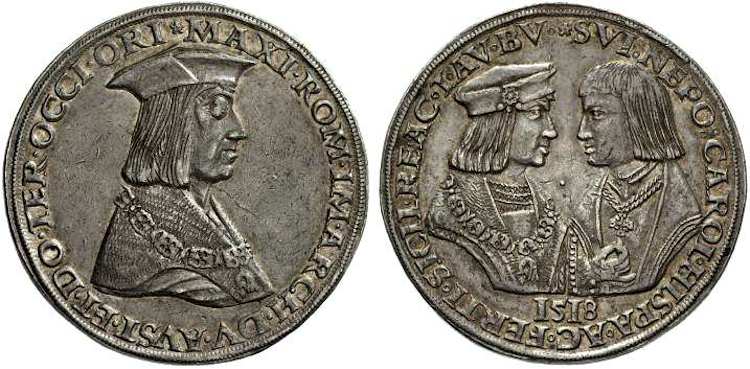Raised central dot on coins of the Early Modern Age
In some coins of the Early Modern Age, a distinctive dot appears in the center. It is particulary prominent if the center is free of images. Central dots can appear on both sides of the coin. However, engraved images frequently hide them.
The central dot is raised on the coin, i.e. it was incused on the die. It was formed before the image was engraved, and is most likely connected to the manufacturing process of the circular border of the die. Central dots seem to be too crude to have served the die cutters as points of reference for the engraving of linear or pearl circles. They are certainly never a part of the coins' images.
Raised central dots appear on European coins minted in the Early Modern Age.
| Apart from the raised central dots, incuse ones are also known: |
| 1. | "Central dots appear especially on ... large bronze coins from Roman Asia Minor. They result from a step in the manufacturing process before the mintage and served in the trimming of the roughly cast flans. The central dot helped to turn off their edges evenly. The mintage could not efface it entirely." [Tyll Kroha, Grosses Lexikon der Numismatik, 1997, my translation] |
| 2. | "Ancient coins often show a so called central dot, sometimes a raised one in the geometric center of the image of all coins cut from the same die, sometimes as conical incuse in the center of the flan. The origin of both is a point at issue." [Frhr. von Schrötter, Wörterbuch der Münzkunde, 1930/70, my translation] |
|
touch the pictures :
you see concentric circles with
same Ø on both sides |
 Reyes Católicos (1469-1504), Doble excelente (post.1497), Sevilla. Ø ~28 mm, 6,8 g
Reyes Católicos (1469-1504), Doble excelente (post.1497), Sevilla. Ø ~28 mm, 6,8 g
The character S and the star are marks for the mint and the assayer. Cayón remarks on the prominent central dot in Spanish: "The dot is not the assayer's or die cutter's secret mark, e.g. to help determine the piecework pay. Instead, it served in the trimming process ... "
This frequent type of gold coins often but not always shows a dot between the effegies. Sometimes the central dot is visible on the reverse, e.g. on a 4-fold-Excelente from Segovia . .
|
 Charles V, Carlino, n.d. (1519-1554), Naples. Ø 23 mm, 3,1 g.
Charles V, Carlino, n.d. (1519-1554), Naples. Ø 23 mm, 3,1 g.
You can easily find a central dot on both sides of the coin, if you search for it.
 Charles V, Tari, 1555, Messina. Ø 26 mm
Charles V, Tari, 1555, Messina. Ø 26 mm
Here, the central dot is unusually bulky on the avers but not visible on the reverse.
 Philip II of Spain, Scudo d'argento, n.d. (1582-88), Milan. Ø 41 mm, 32,16 g.
Philip II of Spain, Scudo d'argento, n.d. (1582-88), Milan. Ø 41 mm, 32,16 g.
This frequent scudo exists in a number of variants. The beard and the dividing line in the coat of arms more or less hide the central dots.
 Carlos II of Spain, Ducaton 1673, Antwerp. Ø ~43 mm.
Carlos II of Spain, Ducaton 1673, Antwerp. Ø ~43 mm.
There is a noticeable central dot on Charles's neck and an unnoticeable in the inner shield (Portugal).
 Austria, Emperor Maximilian and his grandsons Charles and Ferdinand
Austria, Emperor Maximilian and his grandsons Charles and Ferdinand
Schauguldiner "grandson-taler" 1518, Sankt Veit on Glan. Ø 42 mm, 33,15 g.
A central dot on an Austrian coin is quite unusual.
 City of Nuremberg. 4 ducats 1631. off-metal first strike of the taler Ø 42 mm.
City of Nuremberg. 4 ducats 1631. off-metal first strike of the taler Ø 42 mm.
This baroque piece was coined with new dies and shows an undesired central dot on both sides.
More coins with central dots could be presented, e.g. the English shilling 1555 showing Mary Tudor and Philipp II facing each other, also the French teston from Francis I . If you look out for them, you will soon find more samples, e.g. all the Spanish coins of Charles V shown on this site !
A final remark: The central or centering dot seems to have served as point of reference in forming the inner and outer circles on the dies (lines, dashes or pearls). Afterwards, the legend was punched on the dies. Wether or not the central dot also served as point of reference for the manufacturing of the outer edge of the die is not yet clear. |
|






 Startpage
Startpage


